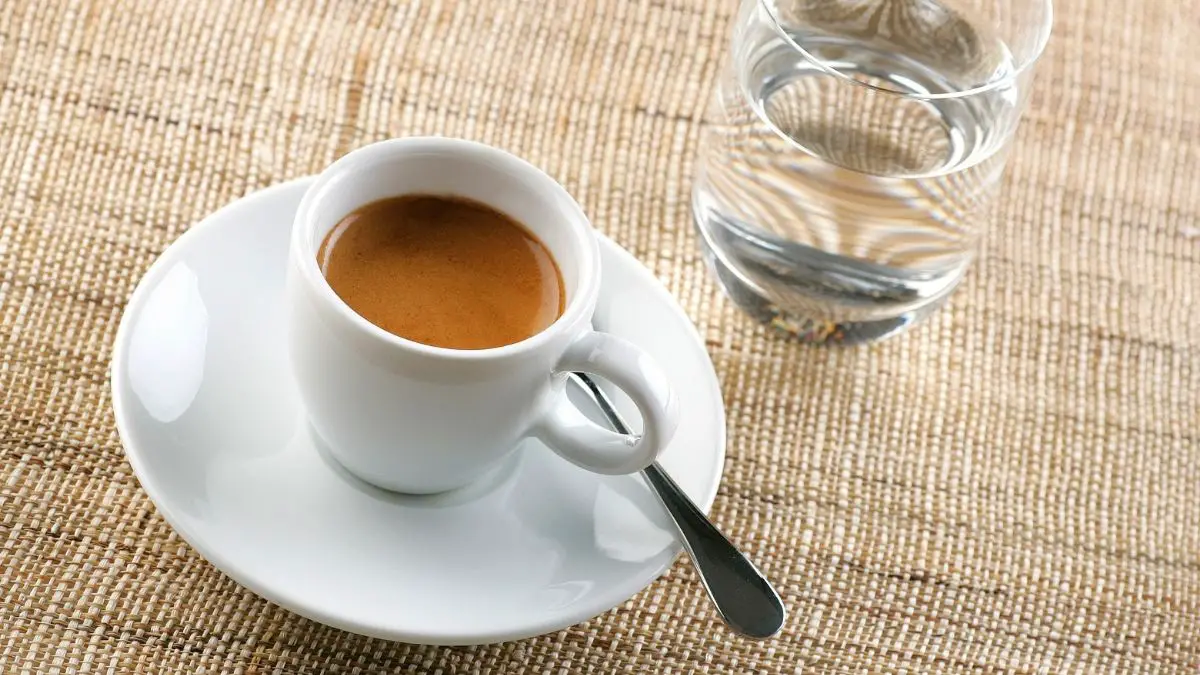Have you ever been to a regular cafe and you suddenly find yourself wanting to try an espresso shot as is, without any milk or water, just to know how strong and bold it would be? If you’ve already done so or if you usually order an espresso shot and drink it straight, then you probably have already noticed how they’d serve the demitasse with a glass of water.
The most accurate and sensible reason why espresso is sometimes served with water, more commonly in the US than Italy, is to cleanse your palate either before or after your drink. A straight shot of espresso is very bold and possesses strong, biting flavors that do stick on your tongue, lips, and cheeks for a while.
Other theories are going around, and it would be worth the time to look into them too. If you’re not very experienced taking espresso straight, then we’ve also got some helpful tips for you. Whether you do like the idea of sipping a pure shot of espresso or not, it’s totally up to you how you want your coffee made and how you want to enjoy it.
What Makes Espresso So Bold?
Unlike your average drip or pour-over coffee, espresso is made with specialized machinery that produces an adequate amount of pressure to saturate the espresso grounds with hot water and finish brewing and extraction within 30 seconds. Manual espresso machines do exist, and they operate with the use of a lever that is pressed down to extract the coffee. But since our force as human beings can be quite limited, we could only pull an espresso shot half or two-thirds as good as one from an automated machine.
But hey if you can create pressure worth 9 bars as in 9 times the standard atmospheric pressure at sea level, then you can probably make that perfect shot with a manual machine! That standard by the way is concluded by the Specialty Coffee Association, so a commercially produced espresso shot must be pulled with about this much pressure.
Espresso is known as a highly-concentrated coffee that’s also rich in caffeine, coffee oils, and healthy polyphenols. These components introduce various taste notes in an espresso, but what makes espresso so strong is its high concentration of coffee oils that would otherwise be dismissed when using a paper filter.
An espresso machine uses a portafilter which is a basket with a metal mesh. This type of filter allows the passage of oils that emulsify with water and gases, creating the crema on top of the espresso. The oils resting on top of the beverage don’t dissolve nor dilute in water, but they create a complex array of aroma, flavor, and mouthfeel, especially in the first sip.
These oils are the same ones that would stick around in your mouth for a while too, and their tastes range from bittersweet, nutty, chocolatey, and sometimes slightly acidic. So if you want to wash down the lingering flavors, then drinking and running water in your mouth would help.
Why Serve Espresso With Water On The Side?
Besides cleansing your palate and tongue anew, there are a couple of other theories that seem interesting and perhaps would also make sense.
Theory 1: A Sign Of Cleanliness
In a time when potable water was a major health concern, baristas would usually serve a clear glass of water beside an espresso cup or any other colored beverage to assure the customer that the water they used is pure and clean.
Theory 2: A Sign Of Hospitality
You realize how in most restaurants in the states, they’d serve you with sparkling water first before any meal or drink, and this is an immediate sign of hospitality and welcome that allows you to cleanse your palate first before enjoying the best of their dishes.
The same could be true with espresso, except that sparkling water isn’t commonly served alongside other coffee beverages though.
Theory 3: A Sign Of Finesse
It’s very common for gourmet diners to wash down their palate first before taking a meal or wine so that they can properly pick up the flavors of each food they taste. With espresso, the key is to appreciate the complexity of its flavors, from the crema to its heart. Each sip is like finding something new and indulging in the novelty of every discovery.
So the best way to experience that is with a clean palate void of mixed flavors and lingering tastes.
How To Drink An Espresso Shot
All it boils down to is simply cleansing your taste buds to receive the fullness of an espresso shot. Also, it’s best to give the cup a gentle shake or stir before drinking so the flavorful layers could blend and each sip won’t be too monotonic. Inhale the aroma to impress your senses and prepare for the first sip.
The crema on top contains the most bittersweet compounds, but its creamy texture envelops the tongue with a fresh, light taste. The middle section of the espresso contains the flavor profile of the roast of which you can truly appreciate the authenticity and freshness of rich grounds. Finally, the bottom part which is the heart of the drink introduces the sweetest and most-concentrated flavors that would last in your palate.
The espresso is served as a two-ounce shot in a preheated demitasse cup. Never let it sit and wait, as the crema could turn into a crusty layer when the coffee gets cold and that might just ruin your day. You can have your water before, during, or after your drink. If it’s your first time drinking an espresso straight, then the water could be handy.
You can drink espresso like a real shot, gulping it down in one go, but that’s unrecommended as once again, appreciation is the key in drinking espresso, and if you don’t give yourself enough time (or espresso) to indulge, then you’re missing out. It’s best to make espresso in three sips and fully realize the taste and feel of each to better understand the complexity of pure coffee.
About The Water
Whether the cafe serves still, sparkling, or mineral water, it doesn’t really matter as the purpose is only to cleanse your mouth, kind of like when you wash your hands before eating. However, if you do prefer any type of water as you think it suits you best, then that’s okay too. Others do prefer sparkling mineral water as still water may just be too plain and bland.
You can drink as much water as you need, but if you drink too much, then you may not be able to properly enjoy your espresso if you’re feeling full with liquid. Serving water with espresso isn’t common in Italy, as they’ve already been used to drinking it straight and prefer the flavors to last in their palate a bit longer.
You can drink water in between your sips, especially if it’s your first, but only take a bit of water each time just so you won’t wash down too much flavor and end up tasting dishwater-like espresso.
Espresso With Water
If you felt a bit uncomfortable drinking espresso as is, then you might want to dilute it in water, and that drink is called an Americano. There is no factual evidence pointing to the exact origins of Caffe Americano, but some affirm that when American G.I.s were stationed in Italy during World War II, they found that the common coffee of the Italians, espresso, was just too strong and pure. So they decided to dilute it in water to give it a similar taste and body to the coffee they’re used to from home.
So an Americano is a version of espresso served in the American style. The ratio of water and espresso in a standard Americano is 2:1 in ounces. This allows the bold flavors of espresso to remain even when dissolved in water. However, it won’t be as strong and thick as the original. The flavor of Americano is pretty similar to black coffee, but stronger because of the presence of oils.
The Americano is a great option if you like to taste a bit of the original flavors of an espresso shot since it’s the only version of espresso that is mixed with water. All other espresso blends contain a form of milk instead, and sometimes cocoa powder and spices.
Espresso For Our Health
Espresso isn’t only a drink for indulgence, but it’s also a very healthy drink that contains about 60 g of caffeine per ounce and is rich in antioxidants that benefit heart, blood, and bone health.
On other papers, espresso is notorious for raising cholesterol because of the oils it contains, especially cafestol and kahweol, and that’s true. However, according to a recent blog from About Time UK, cafestol in espresso raises good cholesterol or HDL that helps flush out bad cholesterol (LDL) more effectively. This then helps reduce the risk of cardiovascular disease and strain.
Still, you can only drink around 6 ounces of espresso a day due to its high caffeine content which may not always be beneficial for you. Caffeine still does help you in many ways and here‘s where you can know a lot about those benefits.
Bottom Line
In the end, how you want your coffee made and how you want to drink it is absolutely up to you. The most important part is you enjoy it and appreciate every sip. Coffee is already a breakfast staple worldwide, and we almost can’t live without it because of how much we need it to boost our days and give us a bit of physical wellness (emotional and mental could also apply).
I definitely recommend you give straight espresso a shot and allow yourself to indulge in its complex flavors and meditate upon each experience. It’s a truly invigorating and delightful experience. Espresso is also a great pick-me-up as it packs a real punch of boldness and caffeine that would surely raise your energy bar to the max.

